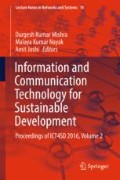Abstract
The Classification of Humanoid locomotion is a troublesome exercise because of nonlinearity associate with gait. The high dimension feature vector requires a high computational cost. The classification using the different machine learning technique leads for over fitting and under fitting. To select the correct feature is also the difficult task. The hand craft feature selection machine learning techniques performed poor. We have used the deep learning technique to get the trained feature and then classification we have used deep belief network-based deep learning. Classification is utilized to see Gait pattern of different person and any upcoming disease can be detected earlier. So in this paper we first selected the feature and identify the principle feature then we classify gait data and use different machine learning technique (ANN, SVM, KNN, and Classifier fusion) and performance comparison is shown. Experimental result on real time datasets propose method is better than previous method as far as humanoid locomotion classification is concerned.
Access this chapter
Tax calculation will be finalised at checkout
Purchases are for personal use only
References
Rattiya Thanasoontornerk, Chatkaew Pongmala, Areerat Suputtiada: Tree Induction for Diagnosis on Movement Disorders Using Gait Data. In: 2013 5th International Conference on Knowledge and smart technology (KST).
Kiichi_Katoh, Makoto Katoh.: Using FS in Tuning a Biped Locomotion Surrogate Robot for Walking Training. In: 2011 4th International Conference on Biomedical Engineering and Informatics (BMEI).
Mitsuru Yoneyama, Yosuke Kurihara, Kajiro Watanabe: Accelerometry-Based Gait Analysis and Its Application to Parkinson’s Disease Assessment—Part 2: IEEE Transactions on Neural Systems and Rehabilitation Engineering, vol. 21, no. 6, November 2013.
M. Ogata, T. Karato, T. Tsuji, H. Kobayashi and K. Irie.: Development of Active Walker by using Hart Walker. In: SICE-ICASE International Joint Conference 2006 Oct. 18–21, 2006 in Bexco, Busan, Korea.
Hiroshi Kobayashi, Takeo Karato, and Toshiaki Tsuji.: Development of an Active Walker as a New Orthosis. Proceedings of the 2007 IEEE International Conference on Mechatronics and Automation August 5–8, 2007, Harbin, China.
Daniel T.H. Lai, Ahsan Khandoker, Rezaul K. Begg and M. Palaniswami.: A hybrid Support Vector Machine and autoregressive model for detecting gait disorders in the elderly. In Proceedings of International Joint Conference on Neural Networks, Orlando, Florida, USA, August 12–17, 2007.
Anubha Parashar, Somya Goyal, Apoorva Parashar, Bharat Sahjalan: Push Recovery for Humanoid Robot in Dynamic Environment and Classifying the Data Using K-Mean. ICTCS 2016 - CSI-Udaipur Chapter.
Daniel T.H. Lai, Ahsan Khandoker, Rezaul K. Begg and M. Palaniswami: A hybrid Support Vector Machine and autoregressive model for detecting gait disorders in the elderly. Proceedings of International Joint Conference on Neural Networks, Orlando, Florida, USA, August 12–17, 2007.
Semwal, Vijay Bhaskar, et al: Biped model based on human Gait pattern parameters for sagittal plane movement. Control, Automation, Robotics and Embedded Systems (CARE), 2013 International Conference on. IEEE, 2013.
Semwal, Vijay Bhaskar, et al.: Biologically-inspired push recovery capable bipedal locomotion modeling through hybrid automata. Robotics and Autonomous Systems 70 (2015): 181–190.
Semwal, Vijay Bhaskar, Manish Raj, and Gora Chand Nandi.: Biometric gait identification based on a multilayer perceptron. Robotics and Autonomous Systems 65 (2015): 65–75.
Author information
Authors and Affiliations
Corresponding author
Editor information
Editors and Affiliations
Rights and permissions
Copyright information
© 2018 Springer Nature Singapore Pte Ltd.
About this paper
Cite this paper
Parashar, A., Parashar, A., Goyal, S. (2018). Classifying Gait Data Using Different Machine Learning Techniques and Finding the Optimum Technique of Classification. In: Mishra, D., Nayak, M., Joshi, A. (eds) Information and Communication Technology for Sustainable Development. Lecture Notes in Networks and Systems, vol 10. Springer, Singapore. https://doi.org/10.1007/978-981-10-3920-1_31
Download citation
DOI: https://doi.org/10.1007/978-981-10-3920-1_31
Published:
Publisher Name: Springer, Singapore
Print ISBN: 978-981-10-3919-5
Online ISBN: 978-981-10-3920-1
eBook Packages: EngineeringEngineering (R0)

